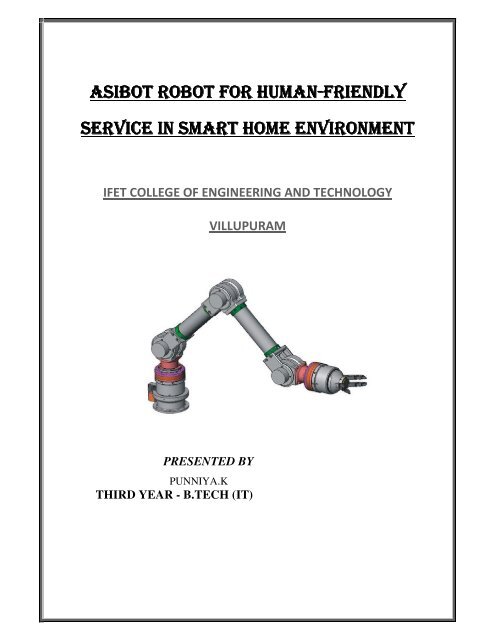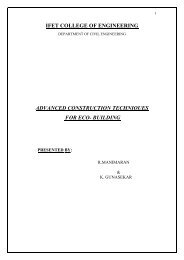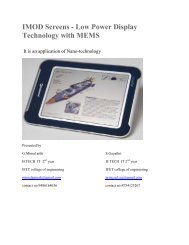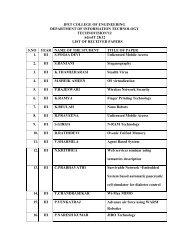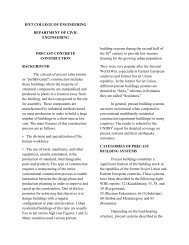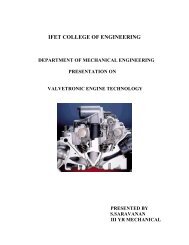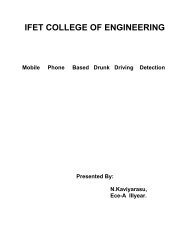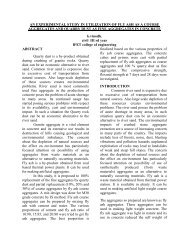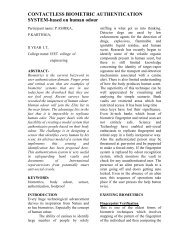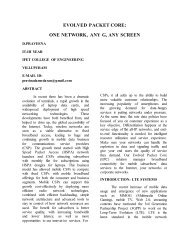asibot robot for human-friendly service in smart home environment
asibot robot for human-friendly service in smart home environment
asibot robot for human-friendly service in smart home environment
You also want an ePaper? Increase the reach of your titles
YUMPU automatically turns print PDFs into web optimized ePapers that Google loves.
ASIBOT ROBOT<br />
R<br />
FOR HUMAN-FRIENDLY<br />
SERVICE IN SMART HOME<br />
ENVIRONMENT<br />
IFET COLLEGE OF ENGINEERING AND TECHNOLOGY<br />
VILLUPURAM<br />
PRESENTED BY<br />
PUNNIYA.K<br />
THIRD YEAR - B.TECH (IT)
Abstract<br />
Historically the k<strong>in</strong>d of technologies used <strong>in</strong> <strong>home</strong>s has been <strong>in</strong> the <strong>for</strong>m of<br />
electrical appliances such as wash<strong>in</strong>g mach<strong>in</strong>es, ovens, etc. Later was <strong>in</strong>troduced<br />
the classic “Home Automation” concept, which <strong>in</strong>volves improvements like<br />
computer-controlled devices such as lights, alarms, different sensors, etc. The<br />
classic devices have always been static, this means they are <strong>in</strong>stalled <strong>in</strong> the house<br />
and stay there dur<strong>in</strong>g all their useful life do<strong>in</strong>g always the same task. In this paper<br />
is presented the next step <strong>in</strong> the <strong>in</strong>troduction of advanced technologies <strong>in</strong> <strong>home</strong><br />
<strong>environment</strong>s. The ma<strong>in</strong> concept is to <strong>in</strong>troduce dynamic and mobile items <strong>in</strong><br />
<strong>home</strong>s, it means <strong>robot</strong>s. The developed <strong>robot</strong> ASIBOT is a mobile device, different<br />
to classic mobile <strong>robot</strong>s, which can travel around the house and can help to<br />
per<strong>for</strong>m a wide variety of task: eat<strong>in</strong>g, cook<strong>in</strong>g, wash<strong>in</strong>g, transportation, etc.<br />
help<strong>in</strong>g people wherever it would be<br />
1. INTRODUCTION<br />
New devices are <strong>in</strong>troduced everyday <strong>in</strong><br />
<strong>home</strong>s to make them more com<strong>for</strong>table and<br />
useful through the automation of many daily<br />
life aspects.. Concrete Ubiquitous Comput<strong>in</strong>g<br />
-<strong>in</strong>tegration of low cost microprocessors <strong>in</strong>to<br />
everyday objects like furniture, cloth<strong>in</strong>g,<br />
white goods, walls, etc. all these processors<br />
are able to talk with the others and Intelligent<br />
User Interfaces, that allows the user to be<br />
<strong>in</strong>tegrated <strong>in</strong>to the ad-hoc wireless<br />
communication systems. The AmI concept<br />
offers an excellent opportunity to, not only<br />
the improvement of domestic <strong>environment</strong>s<br />
towards a more com<strong>for</strong>table ones, but also to<br />
<strong>in</strong>troduce a set of new technology systems<br />
specially useful <strong>for</strong> elderly and people with
special needs achiev<strong>in</strong>g a better way of life<br />
and reach a higher level of <strong>in</strong>dependence.<br />
This paper presents the next step<br />
<strong>in</strong> the <strong>in</strong>troduction of advanced technologies<br />
<strong>in</strong> <strong>home</strong> <strong>environment</strong>s, accord<strong>in</strong>g with the<br />
concept of “modular autonomy”. The ma<strong>in</strong><br />
theme is to <strong>in</strong>troduce dynamic and mobile<br />
items <strong>in</strong> <strong>home</strong>s, it means <strong>robot</strong>s.. The<br />
developed <strong>robot</strong> ASIBOT is a mobile device<br />
which can travel around the house and<br />
per<strong>for</strong>m a wide variety of task: eat<strong>in</strong>g,<br />
cook<strong>in</strong>g, wash<strong>in</strong>g, transportation, etc. help<strong>in</strong>g<br />
people wherever it would be needed. In<br />
comparison with the classic electrical<br />
appliances, this <strong>robot</strong> is an assistant<br />
manipulator designed to help people.<br />
<strong>robot</strong>ics assistant reliable, useful, and<br />
autonomous <strong>in</strong> close <strong>in</strong>teraction with the<br />
<strong>smart</strong> <strong>environment</strong> . In the context of this<br />
development a mobile <strong>robot</strong> is <strong>in</strong>troduced<br />
with<strong>in</strong> the <strong>environment</strong> <strong>in</strong> the most<br />
unobtrusive way possible, the <strong>robot</strong> will use<br />
the walls to move from one po<strong>in</strong>t to another.<br />
Here,the <strong>in</strong>teraction with the <strong>robot</strong><br />
is supported by <strong>in</strong>telligent HMI. That way,<br />
the rest of the elements are controlled through<br />
the HMI, which allows multimodal<br />
<strong>in</strong>teraction <strong>in</strong> order to let the users to give<br />
commands to the Smart Environment, us<strong>in</strong>g<br />
one of the multiple ways to <strong>in</strong>teract with the<br />
<strong>robot</strong> like tactile, a joystick or <strong>human</strong> voice<br />
recognition.<br />
.<br />
2. AMBIENT INTELLIGENT<br />
Ambient Intelligence implies a<br />
seamless <strong>environment</strong> of comput<strong>in</strong>g,<br />
advanced network<strong>in</strong>g technology and specific<br />
<strong>in</strong>terfaces. It is aware of the specific<br />
characteristics of <strong>human</strong> presence and<br />
personalities, takes care of needs and is<br />
capable of respond<strong>in</strong>g <strong>in</strong>telligently to spoken<br />
or gestured <strong>in</strong>dications of desire, and even<br />
can engage <strong>in</strong> <strong>in</strong>telligent dialogue.<br />
With ambient <strong>in</strong>telligent we<br />
understand a new concept of the classic<br />
Home Automation, the next step <strong>in</strong> the<br />
<strong>in</strong>troduction of technology <strong>in</strong> <strong>home</strong><br />
<strong>environment</strong>s. As AmI is a technology<br />
<strong>in</strong>tr<strong>in</strong>sically designed <strong>for</strong> all, it will be the<br />
low cost and effective way to make the<br />
3. ASSISTIVE ROBOT ASIBOT<br />
The ASIBOT <strong>robot</strong> has five degrees of<br />
freedom, and it is divided <strong>in</strong> two parts:<br />
1)a dock<strong>in</strong>g mechanism (DS) to connect the<br />
<strong>robot</strong> to the wall or a wheelchair<br />
2)a gripper.<br />
The body has two l<strong>in</strong>ks that conta<strong>in</strong> the<br />
electronic equipment and the control unit of<br />
the arm. In this way the <strong>robot</strong> is selfconstra<strong>in</strong>ed<br />
be<strong>in</strong>g portable with overall<br />
weight of 11 Kg. It is important to note that<br />
the <strong>robot</strong> is symmetric, due to it is possible to<br />
fix the arm <strong>in</strong> any of its ends. The raw<br />
material is made by alum<strong>in</strong>ium and carbon<br />
fiber. The actuators are torque DC motors,<br />
and the used gears are flat Harmonic-Drive.
The power supply is taken from the connector<br />
that is placed <strong>in</strong> the centre of the dock<strong>in</strong>g<br />
station. The range and the position of the<br />
different jo<strong>in</strong>ts can be seen <strong>in</strong> Fig.1<br />
ASIBOT is designed to be modular<br />
and capable of fitt<strong>in</strong>g <strong>in</strong>to any <strong>environment</strong>.<br />
This means that the <strong>robot</strong> can move<br />
accurately and reliably between rooms and up<br />
or downstairs, and can transfer from/to the<br />
wheelchair. For this purpose the <strong>environment</strong><br />
is equipped with serial dock<strong>in</strong>g stations which<br />
make possible the transition of the <strong>robot</strong> <strong>for</strong>m<br />
one of them to another one.<br />
Fig.1. ASIBOT <strong>robot</strong> design and<br />
its degrees of freedom seen <strong>in</strong> Fig. 1.<br />
This degree of flexibility has significant<br />
implications <strong>for</strong> the care of the disabled and<br />
elderly people with special needs. The<br />
modularity of the system makes possible the<br />
system grows as the level of disability of the<br />
user changes.<br />
The ma<strong>in</strong> functions of the DS are: to fix<br />
mechanically the tip of the <strong>robot</strong> that it’s<br />
work<strong>in</strong>g as a base; and also provide 24V<br />
power supply special DS <strong>in</strong> any room from<br />
which the transition between a fixed DS and<br />
the wheelchair is allowed.<br />
4.CONTROL ARCHITECTURE<br />
Fig. 4 shows the overall control architecture of<br />
the ASIBOT system. Three different levels of<br />
computational tasks are considered, and that are<br />
implemented <strong>in</strong> the follow<strong>in</strong>g subsystems:<br />
1. The Human Mach<strong>in</strong>e Interface (HMI)<br />
2. The Room Controller (RC)<br />
3. The Arm Controller (AC)<br />
The HMI is the device available to the<br />
a) to command the arm functionality.<br />
b) to be <strong>in</strong><strong>for</strong>med about the state of the device<br />
or the task the <strong>robot</strong> is <strong>in</strong>volved.<br />
c) to benefit from the navigational feedback of<br />
offered dur<strong>in</strong>g the transfer manoeuvres<br />
from the wall-mounted dock<strong>in</strong>g station to<br />
the wheelchair dock<strong>in</strong>g station and<br />
vice-versa.<br />
d) to get access to standard application<br />
software,<strong>in</strong>clud<strong>in</strong>g Internet browser and<br />
e-mail.
Fig.4. Overall architecture of the<br />
assistive system<br />
The RC is a computer whose ma<strong>in</strong> functions<br />
are:<br />
a) to per<strong>for</strong>m path-plann<strong>in</strong>g activities, <strong>in</strong><br />
order to the arm be optimally moved with<strong>in</strong><br />
the network of available dock<strong>in</strong>g stations<br />
from a given start po<strong>in</strong>t to a specified target<br />
configuration;<br />
b) to select and send the list of motion<br />
commands needed by the AC to move the<br />
<strong>robot</strong> arm;<br />
c) to per<strong>for</strong>m wheelchair localisation via a<br />
monocular vision-based system built around a<br />
web-cam image sensors (sensor-based<br />
assistance to dock<strong>in</strong>g <strong>for</strong> management of arm<br />
transfer procedures) .<br />
The AC is embedded with<strong>in</strong> the <strong>robot</strong> arm<br />
structure. The ma<strong>in</strong> functions of the AC are:<br />
a)communication management (to <strong>in</strong>teract<br />
with the clients, PDA or RC)<br />
b)commands <strong>in</strong>terpreter,<br />
c)k<strong>in</strong>ematics trans<strong>for</strong>mations (direct<br />
k<strong>in</strong>ematics and <strong>in</strong>verse k<strong>in</strong>ematics), d) pathplann<strong>in</strong>g<br />
(<strong>for</strong> straight l<strong>in</strong>e movements), e)<br />
connection to the amplifiers, and f)<br />
commands to digital <strong>in</strong>puts and outputs, (i.e.:<br />
to open and close the grippers).<br />
5.ASIBOT HMI<br />
Every group of users has different<br />
characteristics, abilities and possibilities, but<br />
most of them are expected to have mobility<br />
problems and probably need to use a<br />
wheelchair.<br />
The device selected to implement the user<br />
<strong>in</strong>terface is a PDA (Pocket PC) <strong>for</strong> many<br />
reasons. One of them is the small size and<br />
weight this k<strong>in</strong>d of devices have. This allows<br />
to be carried out easily by any user or to be<br />
attached to a wheelchair <strong>in</strong> a place visible to<br />
the user. It also has very low power<br />
consumption. Another characteristic is the<br />
easy and versatile ways of control that a PDA<br />
allows. The front of the device is a screen,<br />
which offers tactile capabilities. It almost<br />
doesn’t have buttons, it is just a screen<br />
(fig. 5).<br />
Fig.5. PDA-based users <strong>in</strong>terfaces of<br />
the ASIBOT <strong>robot</strong><br />
There have been developed different<br />
ways to control the <strong>robot</strong> us<strong>in</strong>g a PDA. These<br />
possibilities are: tactile screen, us<strong>in</strong>g a po<strong>in</strong>ter<br />
or a f<strong>in</strong>ger, us<strong>in</strong>g a scann<strong>in</strong>g system and a<br />
button to select options, attach<strong>in</strong>g a joystick.<br />
ASIBOT ROBOT APPLICATIONS<br />
The ma<strong>in</strong> applications of the <strong>robot</strong> are<br />
<strong>in</strong>volved <strong>in</strong> domestic tasks.<br />
Fig.3 shows several work<strong>in</strong>g<br />
<strong>environment</strong>s where ASIBOT <strong>robot</strong>
cooperates to per<strong>for</strong>m some domestic tasks,<br />
such as shav<strong>in</strong>g and dr<strong>in</strong>k<strong>in</strong>g.Dur<strong>in</strong>g these<br />
tasks it is very important the control of the<br />
different trajectories of the arm and its<br />
velocity and acceleration profile, because the<br />
<strong>robot</strong> will move very close to the user. If the<br />
<strong>robot</strong> is mov<strong>in</strong>g with a spoon <strong>for</strong> meal, it will<br />
be crucial if it throws down the meal.<br />
Concept of <strong>robot</strong>-aided apartment<br />
6. ROBOT AIDED-APARTMENT<br />
At the moment, the <strong>robot</strong> has<br />
be<strong>in</strong>g tried <strong>in</strong> the National Hospital of<br />
Paraplegics of Toledo .<br />
Here we put <strong>for</strong>ward an idea of<br />
us<strong>in</strong>g the <strong>robot</strong>s <strong>in</strong> liv<strong>in</strong>g room <strong>environment</strong>,<br />
help<strong>in</strong>g to per<strong>for</strong>m tasks like eat<strong>in</strong>g, dr<strong>in</strong>k<strong>in</strong>g,<br />
grasp<strong>in</strong>g objects, etc. and <strong>in</strong> the bathroom,<br />
assist<strong>in</strong>g users to teeth-wash<strong>in</strong>g etc.<br />
Fig.6. The <strong>robot</strong> <strong>in</strong> an adapted bath<br />
room at the Hospital<br />
Fig. 7 shows the <strong>robot</strong> help<strong>in</strong>g a user to eat.<br />
The next step will be to extend that adaptation<br />
to the rest of the domestic <strong>environment</strong>,<br />
adapt<strong>in</strong>g a real kitchen. The f<strong>in</strong>al objective is<br />
to let the <strong>robot</strong> to complete the whole process<br />
of prepar<strong>in</strong>g by itself a simple meal. A midterm<br />
ma<strong>in</strong> objective is the development of a<br />
second prototype much more <strong>in</strong>telligent,<br />
robust, safe and user-<strong>friendly</strong>.<br />
Fig.7. Eat<strong>in</strong>g task assistance by<br />
ASIBOT<br />
The next picture shows prospective designs<br />
<strong>for</strong> such a kitchen, which is a normal one with<br />
little adaptations.
Fig.8. a) & b) corner design of a kitchen, c)<br />
straight l<strong>in</strong>e design, d) the <strong>robot</strong> <strong>in</strong> the liv<strong>in</strong>g<br />
room.<br />
Depend<strong>in</strong>g on the level of<br />
disability of the user, different types of HMI<br />
has been presented. Human factors are not<br />
only important <strong>for</strong> the command<strong>in</strong>g itself but<br />
also are crucial <strong>for</strong> security issues.<br />
The adaptation of the <strong>environment</strong><br />
to let the system work is simple. It just<br />
requires to <strong>in</strong>stall the connectors (DS) <strong>in</strong> the<br />
right place <strong>in</strong> order to let the <strong>robot</strong> move<br />
around the house, m<strong>in</strong>imiz<strong>in</strong>g the number of<br />
them and maximiz<strong>in</strong>g the reach.<br />
The ellipsoids of manipulability<br />
obta<strong>in</strong>ed from the eigenvalues of the Jacobian<br />
matrix, allow to decide which are the better<br />
locations to fix each DS. The goals are to<br />
achieve the maximum manipulability, but <strong>in</strong><br />
order to get the cheaper solution is necessary<br />
to m<strong>in</strong>imize the number of DS, is a suboptimal<br />
problem. Furthermore, sometimes the<br />
mathematical <strong>for</strong>mulation give impossible<br />
solutions due to the physical constra<strong>in</strong>s <strong>in</strong> the<br />
mechanical fixation of the DS.
7.CONCLUSION<br />
Interaction between <strong>human</strong> and<br />
<strong>robot</strong> <strong>in</strong> a <strong>smart</strong> house <strong>environment</strong> would<br />
take place frequently <strong>in</strong> various <strong>for</strong>ms under<br />
different situations and context.<br />
When special considerations are needed<br />
<strong>for</strong> the resident of the house, as <strong>for</strong> the older<br />
persons or people with physical disabilities,<br />
the <strong>human</strong>-<strong>friendly</strong> design approach is<br />
preferred <strong>in</strong> the sense that a <strong>robot</strong>ic system<br />
should adapts to <strong>human</strong> rather than tra<strong>in</strong><strong>in</strong>g<br />
<strong>human</strong> <strong>for</strong> expert operation of the <strong>robot</strong>ic<br />
system.<br />
In this paper, we have proposed that,<br />
<strong>for</strong> the <strong>robot</strong> system, <strong>in</strong>teraction is considered<br />
as <strong>in</strong>put and output of the HMI module and<br />
that, the <strong>robot</strong> can respond. And then, a<br />
successful example of <strong>human</strong>-<strong>robot</strong><br />
<strong>in</strong>teraction is provided <strong>for</strong> each case <strong>in</strong> <strong>smart</strong><br />
<strong>home</strong> <strong>environment</strong>. Even though that<br />
mach<strong>in</strong>e <strong>in</strong>telligence is a crucial factor <strong>for</strong><br />
this design approach it can be implemented.<br />
The configuration of <strong>in</strong>teraction<br />
between <strong>human</strong> and <strong>robot</strong> <strong>in</strong> terms of<br />
contextual situations is an attempt.<br />
REFERENCES<br />
1) http://<strong>robot</strong>icslab.uc3m.es/<br />
2) “A modular approach to rehabilitation<br />
<strong>robot</strong>ics”.<br />
3) Institute <strong>for</strong> Cognitive Science and<br />
Technology(ISTC)<br />
4) Italian National Research Council<br />
(CNR)


